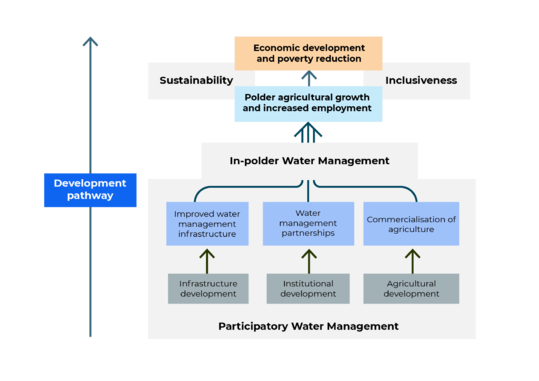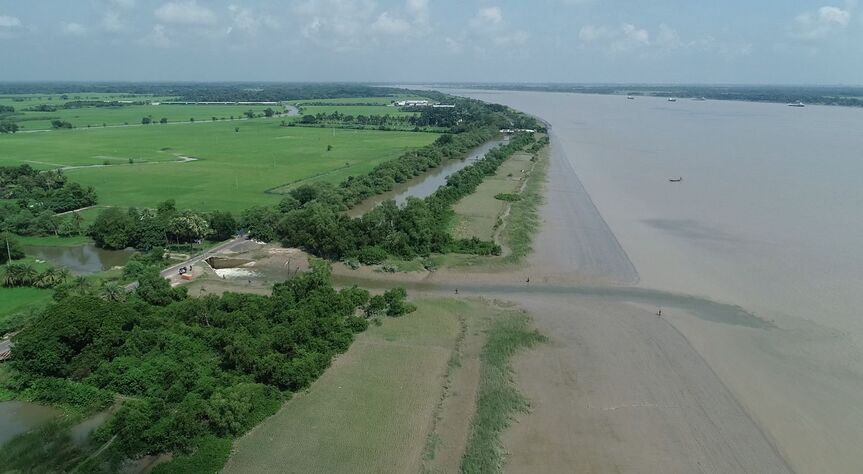Views
Actions
Summary of Section C: Water Infrastructure
The Theory of Change for the Blue Gold Program (BGP) describes the three main sets of interventions -infrastructure, institutional and agricultural development- as the core elements of Blue Gold’s approach.
Section C focuses on the improvements made through Blue Gold to the water infrastructure, specifically the polder embankments and associated structures, and the re-excavation of some of the primary drainage khals within the polder. Later sections cover water management partnerships (Section D), commercialisation of agriculture (Section E) and sustainability and inclusiveness (Section F).
Context[edit | edit source]
The coastal zone in Bangladesh has a complex agro-ecology, with low lying land and huge tidal rivers. To provide protection to agricultural land from tidal and monsoonal flooding and saline water intrusion, around 1.2 million hectares are now enclosed in 139 polders, whose construction started from the 1960s and 1970s. Now, the polders are home to about ten million people.
The tidal rivers draining the coastal zone carry flood flows during the monsoon season but are highly saline during the dry season when outflows in the tidal rivers are at their lowest. The rivers cause greatest damage to polder infrastructure during times of flood and cyclonic storms – compounded during high water spring tides - when the erosive power of the rivers can damage and even breach the polder embankments.
A breach can result in loss of life in severe cases; immediate loss of economic production - crops, fish, livestock, and businesses; damage to infrastructure – roads, utilities, homes, shops, schools; and longer-term impacts on the productivity of agricultural lands. These problems will be increasingly exacerbated by climate change and sea-level rise.
Purpose of Polder Infrastructure[edit | edit source]
Safety[edit | edit source]
One of the primary functions of the polder embankment is to protect the vulnerable communities who live and work in the polders from tidal floods, storm surges, river erosion and salinity through embankment strengthening, breach closing and erosion protection measures. In combination with the infrastructure improvements, disaster risk reduction (DRR) activities involving local community organisations and the concerned government departments has increased the state of preparedness of polder inhabitants to prospects of embankment breaches and overtopping and encouraged consideration of pre-emptive actions.
Water Management[edit | edit source]
Within the polders, the re-excavation of primary canals and some major secondary canals, and rehabilitation of water management structures (sluices, outlets etc) aims to improve the overall water management and to create scope for in-polder water management (IPWM) and community-led agricultural water management (CAWM) – which is discussed in Section D Chapter 17. Where infrastructure works are complete, unobstructed flow of water is possible through the cleared main khals, and the rehabilitated sluices/outlets allow improved water regulation. Previously, many areas were either unable to be drained and remained inundated or suffered water shortages as their main outlets or inlets were obstructed or poorly functioning.
Photo C.1 shows one of the 186 regulators which was rehabilitated under Blue Gold. Note the agricultural area to the left of the tree-lined embankment which protects the polder area (P31-part) from high river levels, and the scale of the tidal river – the Kazibacha River. The regulator drains water into a tidal river – it is low tide so there is drainage from the polder. The high tide mark is fringed by trees and bushes.
Infrastructure Investments[edit | edit source]
A budget of BDT 31,420 lakh (equivalent to Euro 31.20 million) was allocated for infrastructure, in the amounts and proportions indicated in Table C.1 below.
| Item | Allocation
(September 2020) | |
|---|---|---|
| BDT lakh | %age | |
| Embankments (1, 2, 11, 12, 13) | 6,544 | 21% |
| Drainage improvements (3, 14) | 8,932 | 28% |
| Structures (4, 5, 6, 7, 8, 9, 10) | 14,544 | 46% |
| O&M (15,16) | 1,400 | 4% |
| TOTAL | 31,420 | |
| Note: See Table 11.1 for explanation of item numbers | ||
Emergency Repairs[edit | edit source]
In the coastal zone, water infrastructure serving polder communities is expected to provide protection and facilitate water management in a particularly aggressive environment - where floods, cyclones, river erosion and accretion, salinity, tidal flows etc can cause devastating damage to embankments with the associated adverse economic consequences of large-scale flooding, or result in structures falling into disuse and unable to regulate the flow of water in and out of the polder. The resultant heavy repair and maintenance costs required to ensure the continued serviceability of the infrastructure are currently not met in full - because O&M budgets with government organisations such as BWDB are – inevitably – thinly stretched and never sufficient, local government is not mandated for this role, and community contributions fall far short of the huge sums required. This conundrum is well understood but remains unresolved, and because of these gaps, the coastal zone remains locked in a project-driven cycle where infrastructure deterioration both precedes and follows rehabilitation.
Adequate funds for unforeseen emergencies should be made available. Under BWDB rules, funds for “emergency works” are allocated only after a breach is imminent or has occurred. At this stage, costs for repair are much more expensive because land in the vicinity of a breach is flooded, so:
- borrow pits with soils suitable for use in embankments are generally not available close to the site of a breach, so there is a cost of haulage – delivering materials to the site of the breach
- It is difficult to get machinery, equipment and materials to the site of a breach, and required labour gangs and boats
- Access by land to the site of a breach is restricted, along narrow embankments especially constructed to gain access to the breach site
- Soil from borrow pits is often saturated, and achieving acceptable level of soil compaction at high moisture content is impossible.
Pre-emptive action to strengthen vulnerable embankments before they fail is justified because costs of repair of threatened infrastructure (embankments, sluices etc) are much reduced if work is done before embankment failure; and costs in terms of human lives, and damage to crops, livestock, businesses and households can be prevented.
Emergency maintenance is a major role of BWDB in the O&M Agreement between BWDB and the polder-level WMA, and should be extended to include investments for pre-emptive works – with BWDB and WMA together agreeing a prioritized list of actions.
Design Issues[edit | edit source]
Embankments: Climate Change[edit | edit source]
Some of the direct effects of climate change on water infrastructure in the coastal zone includes:
- A rise in sea level resulting in drainage congestion and prolonged waterlogging within the polders
- More frequent cyclones and tidal surges damaging water infrastructure, properties and livelihoods as well as endangering polder communities
- Increased siltation in tidal rivers resulting in reduced drainage capacity, that impedes drainage flows from the polders.
To account for climate change effects in design, consideration was given by BWDB to harmonising Blue Gold design criteria - for raised embankment crest levels, and replacing sluices/outlets compatible with the raised embankment crest heights and with increased numbers of vents - with other projects (including WMIP, ECRRP and CEIP).
It was quickly realised that the direct costs of raising embankment crest levels and replacing regulators exceeded the Blue Gold budget allocation by many orders of magnitude. And this would be compounded by the requirement for significant land acquisition (of a strip of land 4 to 5 times the height increase for marginal and interior bunds, and significantly more for sea dykes) and compensation (eg for the relocation of assets and loss of crops).
During the first years of the project, Blue Gold intended to adopt climate change design levels including a benchmark (BM) correction partly for Polders 26, 31-part and 2. However, due to budget constraints, the 2015 Annual Review Mission recommended that the established design levels should be adopted for the rehabilitation of all Blue Gold polders.
The limited available budget for infrastructure has meant that: (a) the choice of polders for Blue Gold has avoided those requiring high levels of investment; and (b) it has not been possible to achieve embankment crest levels which can meet the 25 year return period maximum surge height (used by CEIP-1), or to upgrade existing structures or construct new structures to suit this higher crest level, or indeed to construct the wider structures (requiring longer culvert barrels) for the higher levels of traffic on roads along the embankments.
Structures[edit | edit source]
Life Cycle Costing[edit | edit source]
After compiling all costs for an element of water infrastructure over its lifespan – including construction, operation, repair, maintenance and rehabilitation – the total can be reduced to a present value with expected return on investment (ROI). The application of life cycle costing in BWDB could achieve a balance between performance (serviceability requirements), risks and overall life cycle cost.
Gates[edit | edit source]
For sluices and regulators to be functional, the gates must act to prevent saline river water from entering the polder (the purpose of the flap gates on the river side), to allow excess water to be drained (by opening the vertical gates on the country side), or to allow freshwater in the rivers - during the monsoon months - to be stored in khals for subsequent use for irrigation (ie operating as a “flushing sluice” when flap gates are raised using a pulley system mounted on a lifting frame).
If the gates are of poor quality or are not properly fitted, then they quickly become inoperable, and thus the major investment in the overall structure becomes quickly un-useable. Although the cost of manufacturing and installing gates on a new regulator varies from 3.3% (1-V) to 6.5% (4-V) of the total cost of the regulator, the functionality of the structure depends on the operability of the gates. Whilst many gated structures in the coastal zone date from the 1960s, gates have a much shorter lifetime especially when they are manufactured from materials such as steel which corrode in a marine environment. There is a strong case for reviewing the design, manufacture and installation of gates to maximise their operating lifetime – taking account of the experience with life cycle costing approaches and the use of composite materials.
Siting of Regulators[edit | edit source]
The siltation of a river channel into which a regulator discharges, is likely to result in the regulator falling into disuse and the loss of a considerable capital investment (of up to €500k for a 4-vent structure), as well as the loss of agricultural benefits within the catchment drained by the regulator. The siting of new regulators on a river channel that will remain active for the 50+ year life of a regulator is a difficult task and relies on expertise in tidal river morphology and historical records.
In cases where regulators become blocked by sediment, internal drainage systems within the polder are re-routed to discharge water to regulators on active rivers. This is assisted by the relatively flat terrain within a polder, and the cross-linking of drainage khals. The drainage capacity of a regulator (ie the number of vents) is determined from the sluice catchment area. By including additional drainage capacity (ie more vents in a regulator) during the design process, it would be possible to reroute and dispose of drainage water from an adjacent regulator which falls into disuse because of sedimentation.
See more[edit | edit source]
| Blue Gold Wiki | |||||||||||||||||||
|---|---|---|---|---|---|---|---|---|---|---|---|---|---|---|---|---|---|---|---|
|

